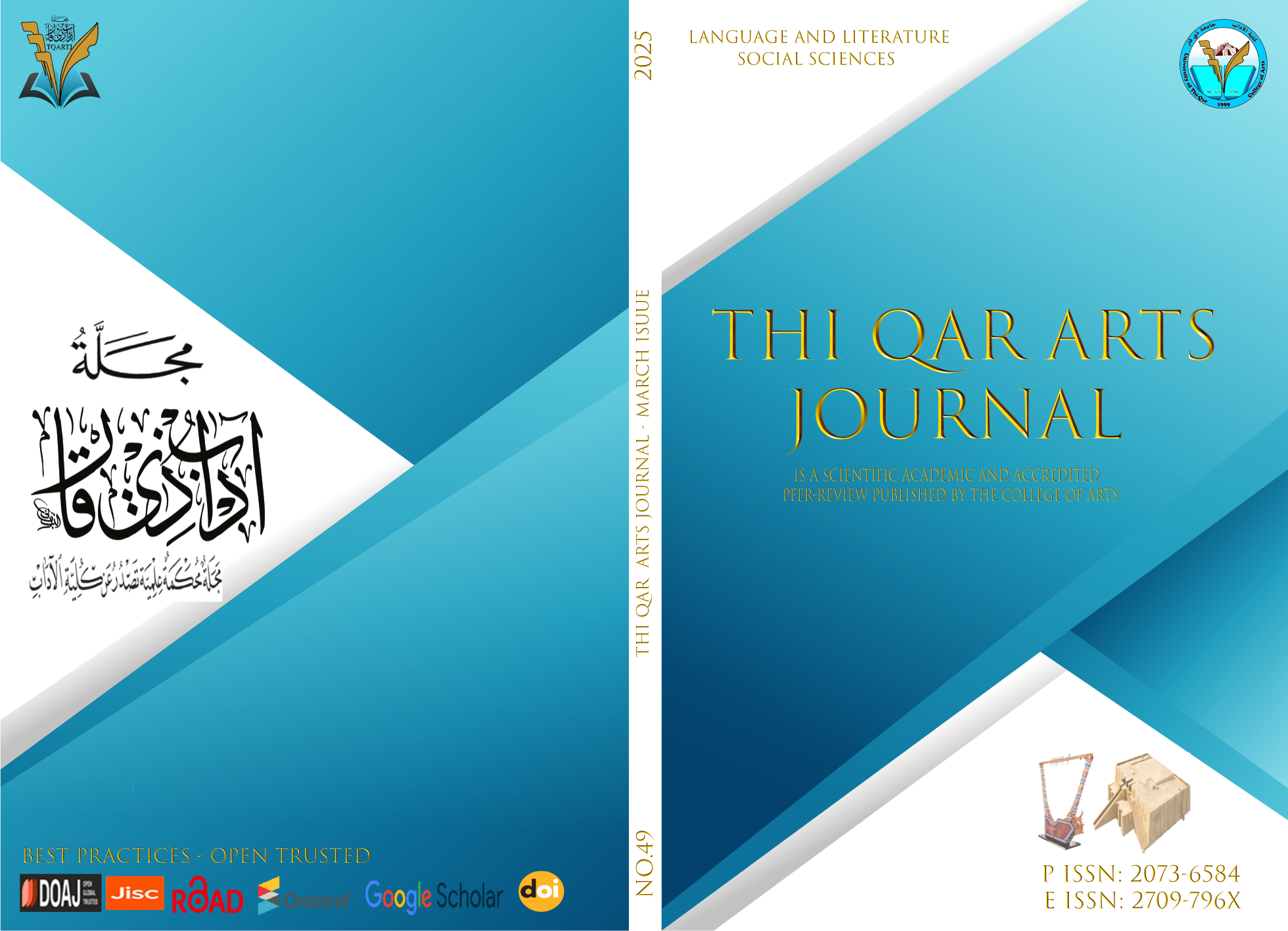Investigating the Psychopathic Mind style of Patrick Bateman in American Psycho
DOI:
https://doi.org/10.32792/tqartj.v1i49.735Keywords:
mind style, cognitive stylistics, text world theory, construalAbstract
the current study aims at analyzing Patrick Bateman's psychopathic mind style in American Psycho novel by the American writer Bret Easton Ellis by adopting a cognitive stylistic perspective. The study aims at exploring how the mind style of the character is constructed textually and investigating the main textual cues and strategies that construe Bateman's mind style. This is conducted by adopting text world theory and cognitive grammar construal. The analysis concludes that world building elements used in the novel contribute to shaping the mind style of Bateman's character. These elements reflect the characters' priorities and establish the foundations for their psychological and cognitive frames. Additionally, The linguistic strategies that contribute to the construal of a psychopathic mind style include certain aspects of construal such as specificity, prominence, dynamicity, and perspective. The importance of such strategies lies in the fact that they show how language presents unique ways through which characters explain, perceive, and represent the real world.
Downloads
References
Brites, José. (2016). The language of psychopaths: A systematic review. Aggression and Violent Behavior. 27. 10.1016/j.avb.2016.02.009.
Cleckley, H.(2013). The Mask of Sanity. An Attempt to Reinterpret the So-Called Psychopathic Personality; Mosby: St. Louis, MO, USA, 1941. 32. American Psychiatric Association. Diagnostic and Statistical Manual of Mental Disorders, 5th ed.; American Psychiatric Association: Washington, DC, USA.
Fowler, R. (1977) Linguistics and the Novel. London: Methuen.
Fowler, R. (1986) Linguistic Criticism. Oxford and New York: Oxford University Press.
Fowler, R. (1996) Linguistic Criticism. 2nd ed. Oxford and New York: Oxford University Press.
Gavins, J. (2007). Text World Theory: An Introduction. Edinburgh: Edinburgh University Press.
Giovanelli, M. (2010). Pedagogical stylistics: A text world theory approach to the teaching of Poetry. English in Education, 44(3), 214-231. DOI: 10.1111/j.1754-8845.2010.01074.x
Glotova, E. (2014). "The suffering minds: Cognitive stylistic approach in "The child who- was- tired" by Catherine Mansfield and "Sleepy" by Anton Chekhov". Theory and Practice in Language Studies. Finland: ACADEMY PUBLISHER. 2445-2454.
Hancock, J. T., Woodworth, M. T., & Porter, S. (2013). Hungry like the wolf: A word‐pattern analysis of the language of psychopaths. Legal and Criminological Psychology, 18(1), 102–114.
Lahey, E. (2005) Text-World Landscapes and English Canadian National Identity in the Poetry of Al Purdy, Milton Acorn and Alden Nowlan, PhD Dissertation, University of Nottingham.
Langacker, Ronald.(2008). Cognitive Grammar: A Basic Introduction. New York : online edn, Oxford Academic.
Mahmoud, Z. A. Z. (2020). A cognitive stylistic analysis of a selection of contemporary egyptian novels. (Doctoral dissertation, Universidad de Salamanca).
Margolin, U. (2007). "Character". In Herman, D. (eds.), The Cambridge Companion to Narrative. Cambridge: Cambridge University Press, 66-79.
Marko, K.; Leibetseder, I.(2023). Linguistic Indicators of Psychopathy and Malignant Narcissism in the Personal Letters of the Austrian Killer Jack Unterweger. Forensic Sci: 3, 45–68. https://doi.org/10.3390/ forensicsci3010006
Semino, E & Culpepper, J.(2002). "Foreword". In Elena Semino and Jonathan Culpeper (eds.) Cognitive Stylistics: Language and Cognition in Text Analysis. Amsterdam: John Benjamins. IX.
Sirinarang, B., & Wijitsopon, R. (2021). "A Cognitive Stylistic Approach to Mind Style in the Memoir Man’s Search for Meaning". Journal of Studies in the English Language, 16(1). Thailand: Chulalongkorn University. 21–52. Available at https://so04.tci-thaijo.org/index.php/jsel/article/view/247503
Van Dijk, T.A. (1977). Text and context: Explorations in the Semantics and Pragmatics of Discourse. London: Longman.
Werth, P. (1995). 'How to build a world (in a lot less than six days and using only what's in your head)', in K. Green (ed.) New Essays on Deixis: Discourse, Narrative, Literature, Amsterdam: Rodopi, pp. 48-80.
Werth, P. (1999). Text Worlds: Representing Conceptual Space in Discourse. London: Longman.
Published
License
Copyright (c) 2025 Zahraa Ali Hasan, Prof. Sarab Khalil Hameed

This work is licensed under a Creative Commons Attribution 4.0 International License.
The journal applies the license of CC BY (a Creative Commons Attribution International license). This license allows authors to keep ownership of the copyright of their papers. But this license permits any user to download, print out, extract, reuse, archive, and distribute the article, so long as appropriate credit is given to the authors and the source of the work. The license ensures that the article will be available as widely as possible and that the article can be included in any scientific archive.



















